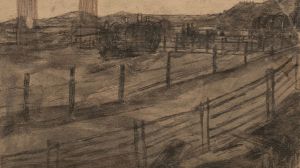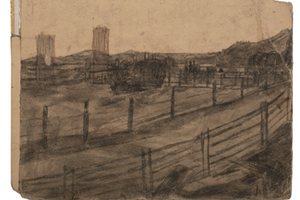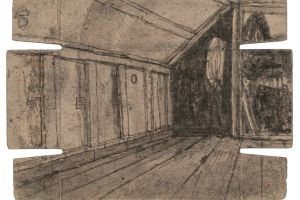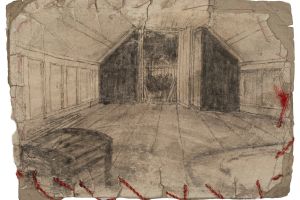
James Castle, Untitled (farmscape), n.d. Found book, soot. 10 x 10.5 inches. Courtesy James Castle Collection and Archive
Overview
As a self-taught artist, born deaf, in a rural agricultural community, James Castle used materials at hand—soot from a woodstove, repurposed paper and cardboard, sharpened sticks and pencils—in the creation of an extraordinary body of work documenting the land and landscapes, buildings and structures, and interior and metaphysical spaces of the world around him. The selected drawings on view at Tinworks are grouped around four subject areas: the mountains surrounding his family home in Garden Valley, Idaho, where Castle spent the early part of his life; the family homestead in Garden Valley, depicted from several viewpoints and set within a variety of landscapes; the approach into and details of a paneled attic storeroom; and an interior space with distinctly patterned wallpaper. Drawn primarily from his memory, Castle’s works reveal a vast amount of information, nuance, and sensitivity. His introspective explorations of past environments and experiences through drawings, paper constructions, abstractions, handmade books, and bundled assemblages carry deep emotional resonance and convey the artist’s unique interconnection of nature, memory, consciousness, perception, and wonder.
About the Artist
James Castle (b.1899 - d.1977), an Idaho-based self-taught artist, created evocative drawings using found paper, soot, and saliva. Over the fifty years of his practice, Castle returned time and again to specific compositions representing Idaho's landscape that encapsulate a profound connection to the region, and present a singular perspective on rural, agrarian environments.
2024 Exhibition Season
This exhibition is part of Tinworks Art’s 2024 exhibition season, The Lay of the Land, which a major new ecological artwork by Agnes Denes and work by five artists inspired by the land of the American West.
With an intergenerational mix of established and emerging artists, iconic work and newly commissioned installations, The Lay of the Land explores how land in the west is represented. The artworks included connect to land and place through their physical materiality—wheat, sediment, soot, clay, the sound of passing trains—and subject matter—the natural or industrial forces that have shaped the land of the west and depictions of western places shaped by memory or technology.

James Castle, Untitled (farmscape), n.d. Found book, soot. 10 x 10.5 inches. Courtesy James Castle Collection and Archive

James Castle, Untitled (attic farmscape). n.d. Found paper, soot. 5.25 x 7.25 inches. Courtesy James Castle Collection and Archive

James Castle, Untitled (attic, open door, trunk), n.d. Found paper, soot, string. 6.5 x 9.25 inches. Courtesy James Castle Collection and Archive